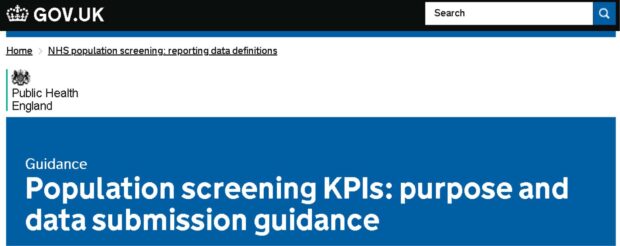Today we’ve published the 2018 to 2019 updated definitions and submission guidance for key performance indicators (KPIs) for the NHS population screening programmes in England.
We review this guidance each year. Today’s publication is valid for KPI data collected from 1 April 2018 through to 31 March 2019.

Publishing in HTML format instead of PDF
The biggest change this year is that for the first time we’re publishing the guidance in HTML format instead of PDF. We’ve previously blogged about the benefits of HTML web pages and how you can navigate through an HTML document. As our KPI guidance now covers the definitions of 30 different indicators, we hope our new HTML format will make it easier for you to find the information you need.
PHE Screening central glossary
We have removed the glossary from the KPI guidance and now refer to PHE Screening’s central glossary of terms. We will update the glossary with more terms over the next few months, so watch this space.
If you would like to see the meaning of an acronym in the standards, hover over it with your cursor and you will be able to see the full definition.
New antenatal screening KPIs
We have 2 new antenatal screening KPIs, one for the fetal anomaly screening programme (FA3) and one for the sickle cell and thalassaemia screening programme (ST4). Both these indicators are already established screening standards. Introducing them as KPIs means we will be able to monitor and quality assure parts of the screening pathway linked to these indicators on a quarterly basis rather than annually as was the case until now.
FA3 is about coverage for Down’s, Edwards’ and Patau’s syndromes. As with other antenatal coverage KPIs it is crucial we understand and are able to accurately identify the eligible cohort. We will use data on exclusions, declines, and individuals not accounted for who may need follow-up to:
- better understand the eligible cohort
- identify possible gaps
- improve the quality of screening services
ST4 measures the timely offer of prenatal diagnosis (PND) to women at risk of having an affected infant. The risk associated with ‘at risk women’ and ‘at risk couples’ is different and it is important to get a better understanding of these 2 groups. For this reason we have split the data collection for this KPI into 2 parts:
- At risk women offered PND by 12 weeks and 0 days gestation (ST4a).
- At risk couples offered PND by 12 weeks and 0 days gestation (ST4b).
These 2 new KPIs will be added to the maternity services template for Q1 2018 to 2019 which we will publish on 1 August (the Q1 submission window runs from 1 to 30 September).
Newborn and infant physical examination KPIs
All trusts (with and without the NIPE Screening Management and Reporting Tool IT system) should continue to submit their data via the maternity services template. The NIPE programme is working towards extracting all NIPE KPI data directly from NIPE SMART.
Revised KPI thresholds and definitions
We have:
- increased the acceptable performance threshold for coverage for newborn hearing screening (NH1) from ≥ 97.0% to ≥ 98.0%
- revised the definition for coverage of the newborn and infant physical examination (NP1) in line with updated standards
- made minor wording updates to the definitions of the 3 diabetic eye screening KPIs in line with the standards although the definitions have not changed
KPI publication dates
Publication dates for the KPI data in 2018 to 2019 are:
- Q1 April to June data: published 14 November 2018
- Q2 July to September data: published 13 February 2019
- Q3 October to December data: published 15 May 2019
- Q4 January to March: published 14 August 2019
Data for a few of the KPIs is collected later than others, so we’ll also update the publications throughout the year as the data becomes available. Make sure you’re signed up to the blog so you’ll know when we’ve published the data and the accompanying summary factsheets.
Please send any queries, suggestions or feedback about the KPIs to the PHE Screening Helpdesk.
PHE Screening blogs
PHE Screening blogs provide up to date news from all NHS screening programmes. You can register to receive updates direct to your inbox, so there’s no need to keep checking for new blogs.